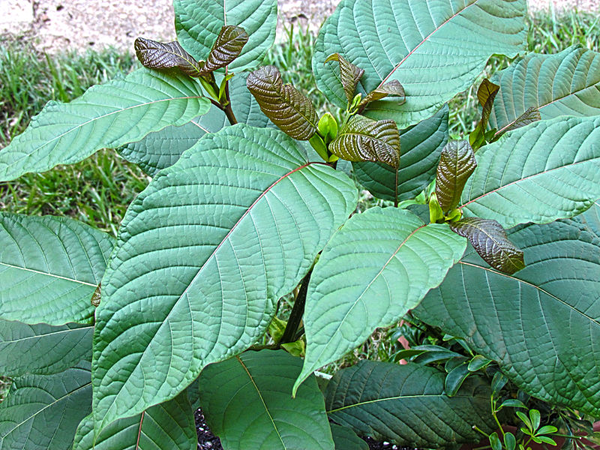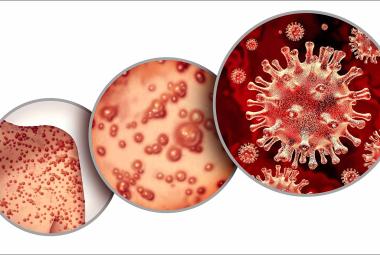Kratom was on the U.S. Drug Enforcement Agency’s (DEA) list of drugs of concern since 20051 and was almost reclassified as a Schedule I drug in 2016. The reclassification was eventually put on hold due to massive public outcry and Kratom currently remains legal in most states in the U.S.2 However, there is no question that the number of Kratom exposures in the US is on the rise. From 2010-2015, U.S poison centers received 660 calls about reported exposures and while there were 26 such calls in 2010, by 2015 there were 263.3 In fact, anonymous posts on online forums suggest that Kratom exposures during pregnancy and breastfeeding are already occurring in the community, despite the lack of scientific literature about its safety in these groups. Awareness about the pharmacologic effects and potential toxicity, dependence and withdrawal with Kratom use needs to be raised among healthcare professionals and the lay public alike, given its increasing popularity as an alternative medicine and recreational drug.
What is Kratom?
Mitragynine , commonly known as “Kratom”, is a tropical tree from the Rubiaceae family that is native to Southeast Asia. Other street names of Kratom include: Thang, Kakuam, Thom, Mambog, Ketum and Biak-biak.1,4 Kratom trees are primarily found in Thailand and Malaysia but is also present in parts of Myanmar, Indonesia, the Phillipines and New Guinea.5,6 The different strains of Kratom are generally grouped by leaf morphology – green vein (Yakyai), white vein (Tang gua), red veins (Kan daeng) and Maeng Da, a genetically enhanced form of Thai Kratom thought to be the most potent.7speciosa
Kratom leaves have been used in folk medicine in Southeast Asia for many years for its psychoactive and opioid-like properties including 1,4,5analgesia and antitussive effects. The leaves were most commonly chewed but were also smoked or brewed into a tea or herbal solution. Pounding of the leaves for application as a wound poultice has also been reported. Workers used Kratom as a stimulant to improve physical endurance and strength so that they could put in more hours of manual labour. As a medicine, Kratom was used in the treatment of minor ailments such as fever, cough, diarrhea and pain as well as chronic conditions like diabetes, depression and hypertension. It was also used as an affordable substitute for opium.
Kratom Use and Abuse
Kratom is now most commonly marketed as a supplement or herbal remedy for chronic pain. It has also gained popularity as an affordable alternative medicine for prescription opioid withdrawal. Today, Kratom is readily available for purchase over the internet, head shops and kava bars in various forms such as powdered leaves, tablets, capsules, gums, dried leaves for chewing or brewing and extracts. In North America, Kratom is most commonly ingested orally in the form of capsules or drunk as a herbal tea.1 Users usually take several doses per day, often repeating doses every 1 to 3 hours. Typical usage appears to involve between 1 and 3 doses a day, though higher doses or more frequent consumption have been documented in user anecdotes.1 The production and sale of Kratom containing products lack regulation and quality control in the U.S. at present.2 The amount of active ingredients present in preparations claiming to contain Kratom may vary and cases of adulteration have occurred. Griffin and co-workers purchased and tested 15 Kratom products from various sources (online, convenience stores and head shops) and found that 2 out of the 15 products did not contain Mitragynine, the main active ingredient in Kratom.7 Lydecker and co-workers tested several Kratom capsules, a liquid drink and an extract and found that some of these products contained up to 5 times more 7-hydroxymitragynine than that naturally present in Kratom leaves.8 Since 7-hydroxymitragynine is the more potent psychoactive compound present in Kratom, artificially increasing its content in supplements could increase the abuse and addictive potential of these products. These studies highlight the variation in quality and contents of Kratom preparations and emphasize the possible dangers of using these unregulated products.
Recreational use of Kratom stems from its psychoactive properties and its ability to provide the user with a feeling of being “simultaneously stimulated and relaxed”.1 Kratom has been abused alone in the form of “Kratom tea parties” or in combination with other drugs such as the likes of the “4X100” cocktail – a concoction of Kratom tea, cough syrup, Coca-Cola and ice cubes abused by Thai youths.1,4 Based on information from calls to U.S. poison centers, the most common co-ingestants with Kratom were alcohol, other botanicals, benzodiazepines, narcotics and acetaminophen.3 There have also been case reports of liver toxicity, seizures and deaths associated with Kratom exposure.9-13 However, it is important to note that so far, deaths involving kratom exposure all involved other co-ingestants, whether intentional or not.10-13 Deaths solely attributable to kratom exposure have not occurred to date. For example, the Kratom product “Krypton” that was linked to 9 deaths in Sweden was found to contain O-desmethyltramadol, the main active metabolite of the opioid analgesic Tramadol, in addition to powdered Kratom leaves.10
Pharmacology of Kratom
As with other botanicals, Kratom preparations contain numerous phytochemicals, making 6 Alkaloid content of the leaves range from 0.5-1.5% and the varying proportions of different alkaloids present in the leaves of different strains likely explain the differences in stimulant and sedative effects of each strain.14 The pharmacology of Kratom has yet to be fully understood but it appears to act on a broad range of receptors. Kratom’s action on the mu and delta opioid receptors is responsible for its analgesic properties while its stimulant effects are thought to be contributed by action on serotonin (5-HT2A) and alpha-2 adrenergic receptors. Additional psychoactive properties of Kratom are thought to be related to its high affinity for central delta and kappa opioid receptors. 14analysis of its pharmacology and toxicology a complex affair. Kratom leaves have been found to contain more than 40 alkaloid compounds.
The main psychoactive compounds in the Kratom leaves are mitragynine and 7-hydroxymitragynine. They are relatively small molecules; the molecular weight of Mitragynine is 398 g/mol while that of 7-hydroxymitragynine is 414 g/mol.15,16 Although they act on similar receptors as the opioids, structurally, they are different. Mitragynine is the predominant psychoactive compound found in kratom, and makes up 12-66%1,6 of the alkaloid content of kratom leaves depending on the strain and origin of the leaves. It is a partial opioid agonist with effects like morphine. 7-hydroxymitragynine is another important psychoactive compound found in Kratom. While it is present in much smaller amounts (2%)6, it is a full opioid agonist with high affinity for opioid receptors and is thought to be 4 times more potent than mitragynine in its effect on the central nervous system.14
Pharmacodynamics and Pharmacokinetics
Mitragynine is poorly soluble in water and is “fat-loving” in nature, possibly explaining its ability to cross the blood-brain barrier and exert its psychoactive effects.
The pharmacodynamics effects of Kratom are dose-dependent and are illustrated in the table below.14,17 Unlike opioids, at low to moderate doses, Kratom produces more of a stimulant effect. Opioid-like effects occur at higher doses but the euphoria induced is reported to be less intense compared to opioid drugs and respiratory depression has not been reported, even at high doses. The strain and dosage of the Kratom used appear to control the relative degree of stimulatory versus sedating or analgesic effect achieved. For example, the Bali red vein strain is thought to have more powerful analgesic effects while the Malaysia white and green vein strains are thought to be more stimulating and have better mood enhancing effects.14

Adapted from:
Warner ML, Kaufman NC, Grundmann O. International journal of legal medicine. 2016;130(1):127-138.
Chang-Chien GC, Odonkor CA, Amorapanth P. Pain physician. 2017;20(1):E195-e198.
The onset of Kratom’s effects appears to be delayed by food and the form of Kratom taken. When Kratom teas and extracts are ingested by mouth on an empty stomach, 1,14onset of effect usually occurs within 10 to 20 minutes. On the other hand, taking Kratom capsules on a full stomach can delay onset of action by 1 to 3 hours. Chewing the leaves appear to produce the most immediate effects with euphoria lasting up to 1 hour occurring within 5 to 10 minutes of consumption. The stimulating effect of Kratom typically lasts 1 to 2 hours while the sedating effects last longer, typically another 1 to 3 hours. Duration of action lasts between 2 to 7 hours and users have reported lingering after effects lasting from anywhere between several hours to till the next day.
There are limited studies investigating the pharmacokinetics of Kratom in humans. In-vitro studies18,19, studies done in rats1, and data from the only pharmacokinetic study done in humans to date20 suggest that the psychoactive compounds in Kratom are degraded by stomach acid and are largely bound to plasma proteins (>90%). After oral consumption, rather than staying in the plasma, these compounds move into the body tissues and are subsequently metabolized by the liver and eliminated in the urine. Elimination half-life of Kratom reported varies widely, from 3.85 to 9.43 hours in rats1 to 23 hours in the study done in humans20
Chronic Toxicity, Dependence and Withdrawal
Side effects that have been reported with regular, chronic use of Kratom for more than a year and include nausea, weight loss, fatigue, constipation, insomnia, dehydration resulting in increased thirst, frequent urination, and hyperpigmentation of the cheeks.5,14 These effects appear to be dose related.
Daily use of Kratom may lead to dependence. In a cross-sectional survey done on chronic Kratom users in Malaysia, 79% of respondents reported they had to use Kratom daily and 32% reported having to increase their intake of Kratom.21 Withdrawal symptoms resembling opioid withdrawal have been described. These can be classified into two categories which include:
Physical withdrawal symptoms5,14,17,21:
- Insomnia, decreased appetite, nausea, vomiting, muscle spasm and pain, sweating, fever, abdominal pain, diarrhea, headaches, hot flashes, watery eyes and nose, hiccups and shakiness or tremors
Psychological withdrawal symptoms5,14,17,21:
- Anxiety, restlessness, tension, anger, hostility, aggression, sadness, confusion, delusion, hallucination, intense craving
Withdrawal symptoms appear to begin 18 to 24 hours after the last dose and typically continue for 1 to 14 days.1 The severity of withdrawal symptoms reported vary widely. In most cases, withdrawal symptoms seem milder than opioid withdrawal and social function of dependent individuals are typically not impacted as in opioid withdrawal.5 However, there are reports of Kratom withdrawal causing significant pain that severely affected the individual’s work performance and mental state.1,21
Use in Pregnancy and Lactation
Based on what we know about the chemistry of Mitragynine and 7-hydroxymitragynine in Kratom, some degree of transfer to the milk and to the unborn fetus can be expected. The extent of the effects of maternal Kratom consumption on the unborn fetus and breastfeeding infant is unknown. Moreover, there are numerous other compounds that Kratom contains that may be of concern.
The safety of Kratom in pregnancy and lactation has not been studied and we would not recommend the use of this product in pregnant or breastfeeding women. Most importantly, because Kratom products are not regulated, the risks of consuming contaminated and/or adulterated products significantly outweigh any potential benefit in this population. Pregnant or breastfeeding women who are using Kratom are encouraged to inform their healthcare providers and they should wean off these products.
Cynthia Leow, BSc. (Pharm)(Hons)
Thomas W. Hale, R.Ph, Ph.D
InfantRisk Center
References
- Raffa RB. Kratom and Other Mitragynines: The Chemistry and Pharmacology of Opioids from a Non-Opium Source. CRC Press; 2014.
- Prozialeck WC. Update on the Pharmacology and Legal Status of Kratom. The Journal of the American Osteopathic Association. 2016;116(12):802-809.
- Anwar M, Law R, Schier J. Notes from the Field: Kratom (Mitragyna speciosa) Exposures Reported to Poison Centers - United States, 2010-2015. MMWR Morbidity and mortality weekly report. 2016;65(29):748-749.
- KRATOM (Mitragyna speciosa korth). 2013; https://www.deadiversion.usdoj.gov/drug_chem_info/kratom.pdf. Accessed Feb 2, 2017.
- Singh D, Narayanan S, Vicknasingam B. Traditional and non-traditional uses of Mitragynine (Kratom): A survey of the literature. Brain research bulletin. 2016;126(Pt 1):41-46.
- Cinosi E, Martinotti G, Simonato P, et al. Following "the Roots" of Kratom (Mitragyna speciosa): The Evolution of an Enhancer from a Traditional Use to Increase Work and Productivity in Southeast Asia to a Recreational Psychoactive Drug in Western Countries. Biomed Res Int. 2015;2015:96878
- Griffin OH, 3rd, Daniels JA, Gardner EA. Do You Get What You Paid For? An Examination of Products Advertised as Kratom. Journal of psychoactive drugs. 2016;48(5):330-335.
- Lydecker AG, Sharma A, McCurdy CR, Avery BA, Babu KM, Boyer EW. Suspected Adulteration of Commercial Kratom Products with 7-Hydroxymitragynine. Journal of medical toxicology : official journal of the American College of Medical Toxicology. 2016;12(4):341-349.
- Nelsen JL, Lapoint J, Hodgman MJ, Aldous KM. Seizure and coma following Kratom (Mitragynina speciosa Korth) exposure. Journal of medical toxicology : official journal of the American College of Medical Toxicology. 2010;6(4):424-426.
- Kronstrand R, Roman M, Thelander G, Eriksson A. Unintentional fatal intoxications with mitragynine and O-desmethyltramadol from the herbal blend Krypton. Journal of analytical toxicology. 2011;35(4):242-247.
- Holler JM, Vorce SP, McDonough-Bender PC, Magluilo J, Jr., Solomon CJ, Levine B. A drug toxicity death involving propylhexedrine and mitragynine. Journal of analytical toxicology. 2011;35(1):54-59.
- Rosenbaum CD, Carreiro SP, Babu KM. Here today, gone tomorrow...and back again? A review of herbal marijuana alternatives (K2, Spice), synthetic cathinones (bath salts), kratom, Salvia divinorum, methoxetamine, and piperazines. Journal of medical toxicology : official journal of the American College of Medical Toxicology. 2012;8(1):15-32.
- Neerman MF, Frost RE, Deking J. A drug fatality involving Kratom. Journal of forensic sciences. 2013;58 Suppl 1:S278-279.
- Warner ML, Kaufman NC, Grundmann O. The pharmacology and toxicology of kratom: from traditional herb to drug of abuse. International journal of legal medicine. 2016;130(1):127-138.
- National Center for Biotechnology Information. PubChem Compound Database; CID=3034396. https://pubchem.ncbi.nlm.nih.gov/compound/3034396. Accessed Feb 3, 2017.
- National Center for Biotechnology Information. PubChem Compound Database; CID=44301524. . https://pubchem.ncbi.nlm.nih.gov/compound/44301524. . Accessed Feb 3, 2017.
- Chang-Chien GC, Odonkor CA, Amorapanth P. Is Kratom the New 'Legal High' on the Block?: The Case of an Emerging Opioid Receptor Agonist with Substance Abuse Potential. Pain physician. 2017;20(1):E195-e198.
- Ramanathan S, Parthasarathy S, Murugaiyah V, Magosso E, Tan SC, Mansor SM. Understanding the physicochemical properties of mitragynine, a principal alkaloid of Mitragyna speciosa, for preclinical evaluation. Molecules (Basel, Switzerland). 2015;20(3):4915-4927.
- Manda VK, Avula B, Ali Z, Khan IA, Walker LA, Khan SI. Evaluation of in vitro absorption, distribution, metabolism, and excretion (ADME) properties of mitragynine, 7-hydroxymitragynine, and mitraphylline. Planta medica. 2014;80(7):568-576.
- Trakulsrichai S, Sathirakul K, Auparakkitanon S, et al. Pharmacokinetics of mitragynine in man. Drug design, development and therapy. 2015;9:2421-2429.
- Singh D, Muller CP, Vicknasingam BK. Kratom (Mitragyna speciosa) dependence, withdrawal symptoms and craving in regular users. Drug and alcohol dependence. 2014;139:132-137.
- Image source: https://en.wikipedia.org/wiki/File:Kratom_tree.jpg







